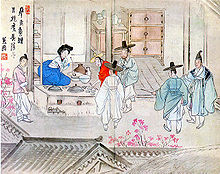| Jumak | |
 In Shin Yun-bok's genre painting titled Jusa geobae ("Holding a drinking party"), a jumak is depicted. | |
| Korean name | |
|---|---|
| Hangul | 주막 |
| Hanja | |
| Revised Romanization | jumak |
| McCune–Reischauer | chumak |
Jumak (Korean: 주막) were traditional Korean taverns or inns[1] that provided alcohol, food, and lodgings to travellers.[2] They are also called juju (酒肆), juga (酒家), or jupo (酒舖). Jumak were abundant during the Joseon Dynasty and could be found in both rural and urban areas. Jumak came in many varieties with some having stables for livestock, courtyards, and gardens.
One early mention of a jumak was one called Cheongwan (天官) that was owned by a kisaeng (female entertainer).
The Gyeongguk Daejeon (경국대전), devised in 1485 provided rules and regulations concerning the establishments.
- ^ National Research Institute of Cultural Heritage (2013). "Jumak". Sul, Korean Alcoholic Beverages. 길잡이미디어. p. 140. ISBN 9788929901769. Retrieved 27 February 2017.
- ^ "History of Bars". life in Korea. Archived from the original on 2009-03-05. Retrieved 2009-02-22.
